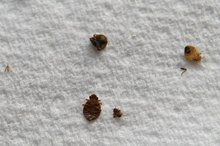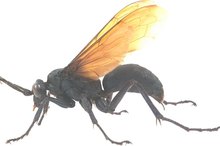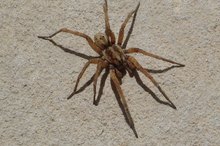Carpenter Bee Sting Reaction
Named for their tendency to bore nesting holes in wooden structures, carpenter bees inhabit areas throughout the United States. Like most kinds of bees, a carpenter bee rarely stings unless it is handled or its nest is threatened, but its sting can result in a painful local reaction. In rare cases, a more serious allergic reaction occurs. Carpenter bees are important pollinators and are common in gardens and other outdoor areas.
If you are experiencing serious medical symptoms, seek emergency treatment immediately.
Carpenter Bee Identification
Carpenter bees have thick, partially hairy bodies that sometimes measure up to 1 inch long. Although carpenter bees and bumblebees are similar in appearance, you can tell the difference by looking at their rear section, or abdomen. Bumblebees have furry abdomens, while carpenter bee abdomens are black, shiny and lack significant hair growth. Many carpenter bee species inhabit various parts of the United States. The majority of them, such as the most common species, Xylocopa virginica, display a combination of black and yellow coloration. The entire body of one western species, Xylocopa californica, is a shiny, bluish-black.
- Carpenter bees have thick, partially hairy bodies that sometimes measure up to 1 inch long.
- The majority of them, such as the most common species, Xylocopa virginica, display a combination of black and yellow coloration.
Behavior and Stinging
Are Velvet Ants Dangerous to Humans?
Learn More
Carpenter bees lack the complex social structure of honeybees and other hive bees and tend to nest in pairs. The female carpenter bee bores a nesting hole and guards her young, while the male patrols the area. Males are fiercely territorial, dive-bombing and attempting to drive away anyone and anything that approaches the nest. However, these are empty threats because male carpenter bees lack stingers and are harmless. Only female carpenter bees are capable of stinging, and they usually do so only when handled or when their nest is directly attacked.
- Carpenter bees lack the complex social structure of honeybees and other hive bees and tend to nest in pairs.
- Only female carpenter bees are capable of stinging, and they usually do so only when handled or when their nest is directly attacked.
Typical Sting Reactions
The sting of a carpenter bee is similar to that of a bumblebee and delivers a venom containing melittin, which causes pain, swelling and redness in the area around the sting site. A sharp pain is typical for a few minutes after being stung, and a dull ache follows, according to University of California Integrated Pest Management, which adds the site can remain sensitive to touch for a few days 5. The site may itch, too.
Unlike a honeybee, a carpenter bee and a bumblebee have a smooth stinger that does not become detached in the victim's body. That feature makes each carpenter bee and bumblebee capable of multiple stings. Because carpenter bees are solitary insects and do not attack in swarms, being stung by more than one carpenter bee at once is rare.
- The sting of a carpenter bee is similar to that of a bumblebee and delivers a venom containing melittin, which causes pain, swelling and redness in the area around the sting site.
Bee Sting Treatment and Allergic Reactions
What Happens When a Carpenter Bee Stings?
Learn More
Carpenter bee stings are not dangerous for most people. The Abrons Student Health Center at the University of North Carolina in Wilmington recommends resting and elevating the affected body part, and applying cold packs off and on for the first 24 hours after the sting, placing one or two layers of cloth between the sting site and the cold packs 4. Over-the-counter antihistamines and painkillers can be used to reduce swelling and pain, respectively.
Individuals with an allergy to bee and wasp stings may develop more serious symptoms, such as nausea or a whole-body rash, along with potentially life-threatening reactions, including shock and difficulty breathing. Seek medical treatment immediately if you develop any of those symptoms.
- Carpenter bee stings are not dangerous for most people.
- Individuals with an allergy to bee and wasp stings may develop more serious symptoms, such as nausea or a whole-body rash, along with potentially life-threatening reactions, including shock and difficulty breathing.
Related Articles
References
- Oklahoma Cooperative Extension Service: Honeybees, Bumble Bees, Carpenter Bees and Sweat Bees
- Utah State University Extension: Carpenter Bees
- Bee Spotter, University of Illinois at Urbana-Champaign: Bee Stings
- University of North Carolina-Wilmington, Abrons Student Health Center: Instruction Sheet -- Bee Sting, Local Reaction
- University of California Integrated Pest Management: Bee and Wasp Stings
- Kleppe, S. "Carpenter Syndrome". National Organization for Rare Disorders, 2015.
- U.S. National Library of Medicine. "Carpenter Syndrome." 2007
Writer Bio
Richard Corrigan has been a full-time professional writer since 2010. His areas of expertise include travel, sports and recreation, gardening, landscaping and the outdoors. He earned a Bachelor of Arts in English from SUNY Geneseo in 2009.








